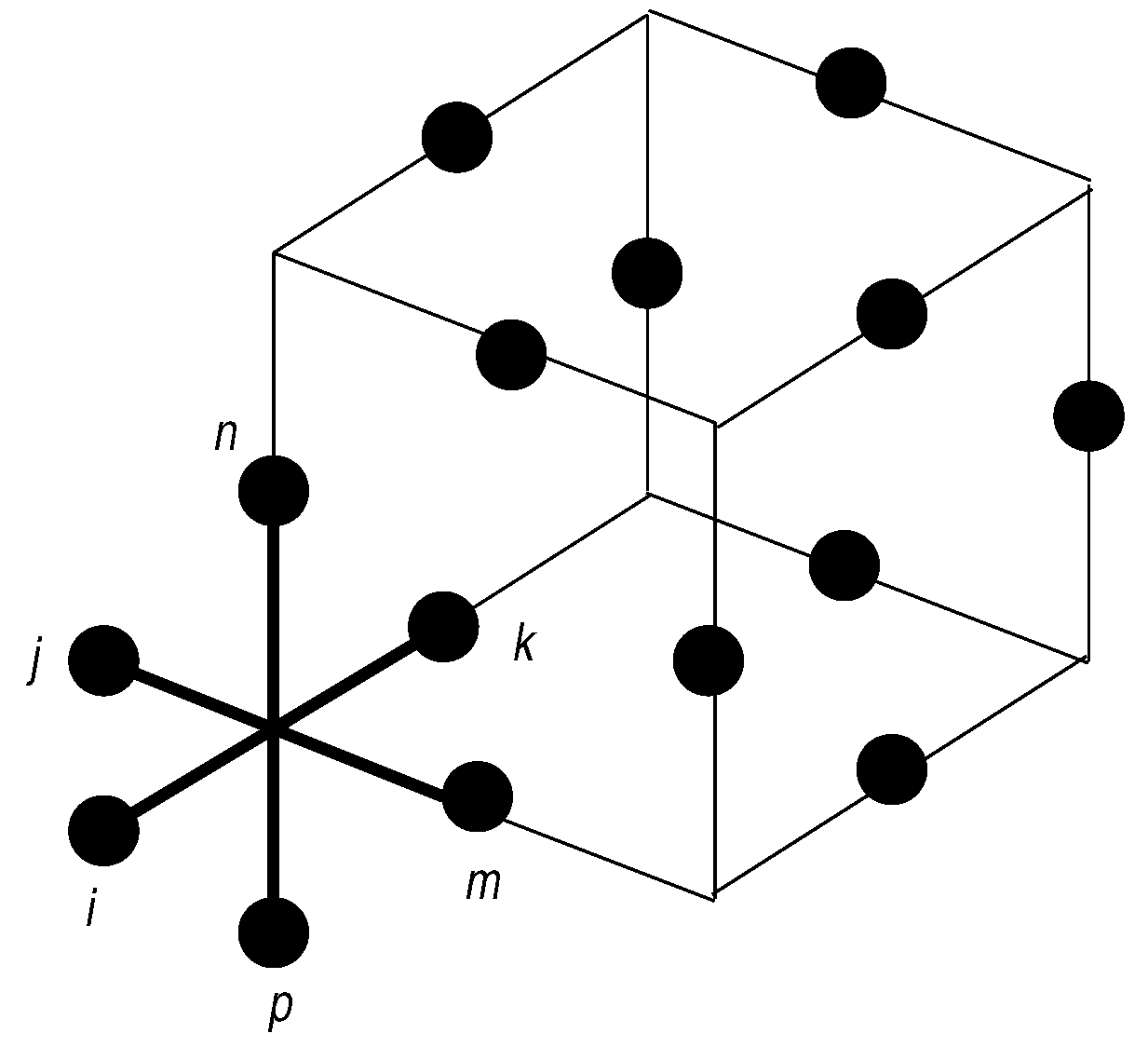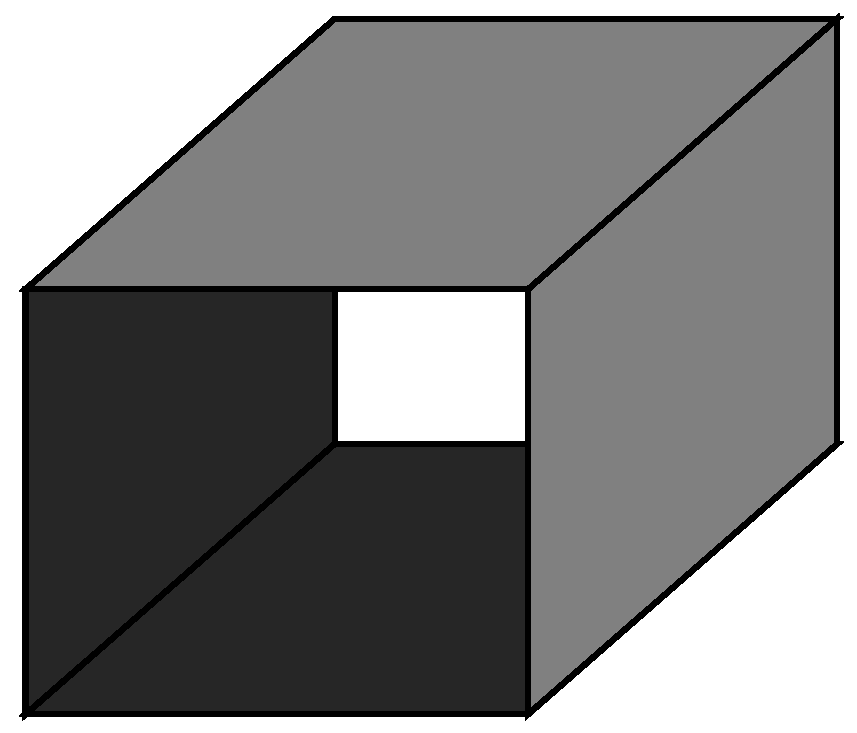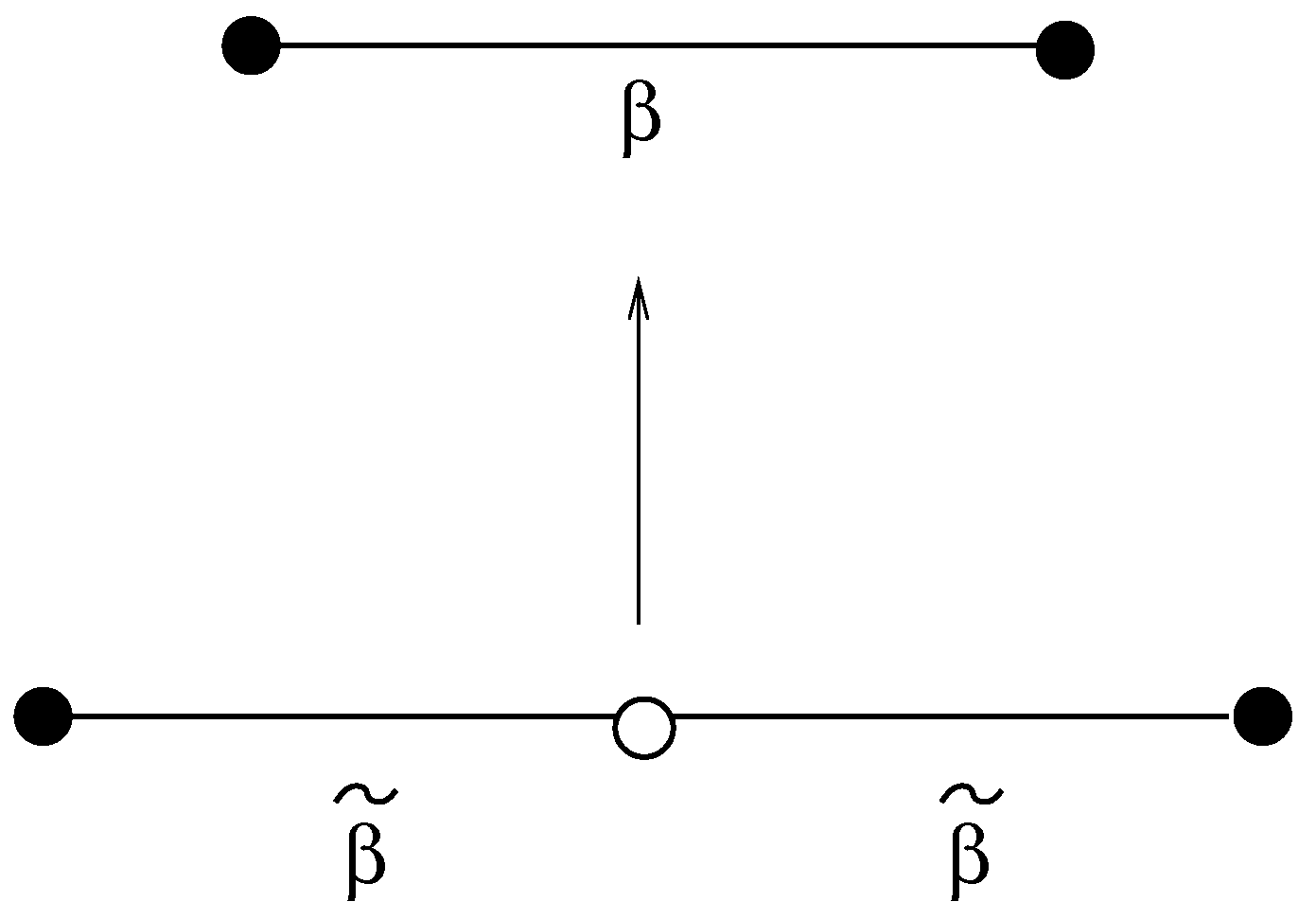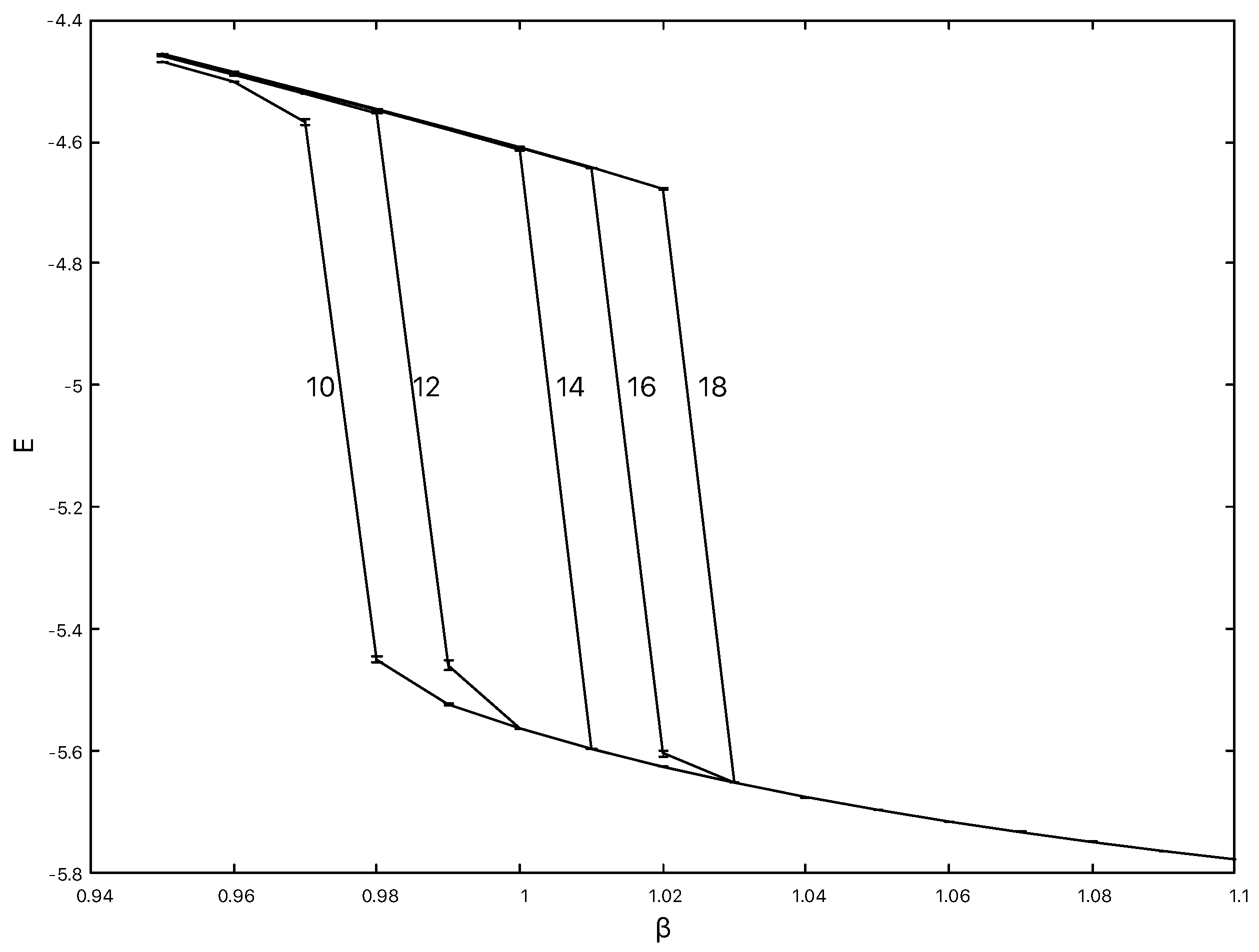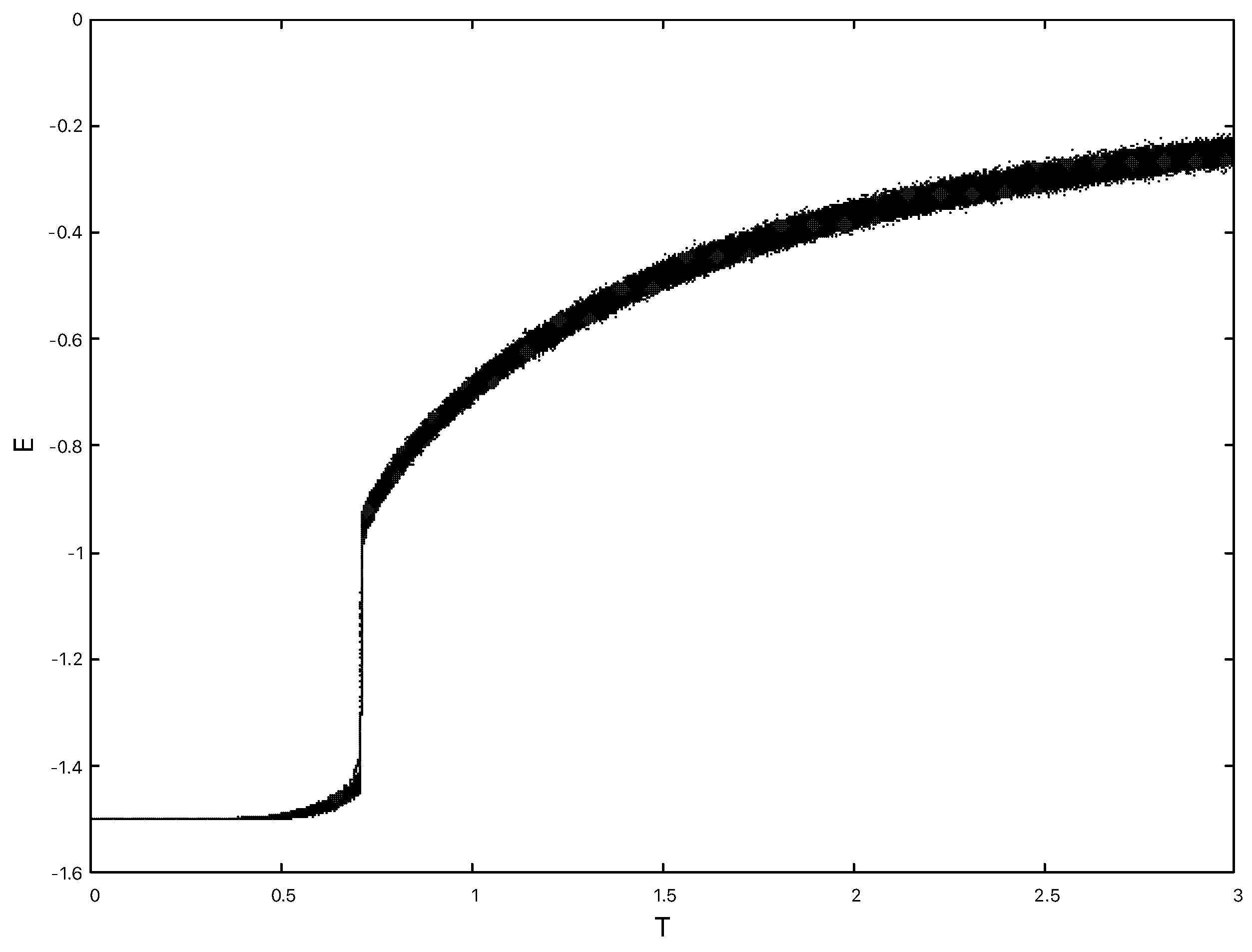1. Introduction
The Kramers–Wannier dual [
1] of the classical Ising Hamiltonian with nearest neighbour
couplings on a
cubic lattice
is the
Ising gauge theory
where the sum runs over plaquettes □ and the gauge spins
U live on the edges of the plaquettes. The coupling
in the partition function
and its dual
in
are related by
. We use un-superscripted variables, e.g.,
, to denote spins in classical Hamiltonians and superscripted variables, e.g.,
, to denote the Pauli matrices appearing in quantum Hamiltonians. The positional subscript indices
are occasionally omitted for brevity.
In this paper we will investigate the relation between four (apparently) different formulations of the dual to the
plaquette Ising model, which has also been dubbed the
gonihedric Ising model [
2,
3,
4,
5]
This, like the
Ising gauge theory, has a plaquette □ interaction but the spins now reside at the vertices of a
cubic lattice rather than on its edges. The subscript
appears because this plaquette Hamiltonian is a particular case of a one-parameter family of gonihedric Hamiltonians
defined by Savvidy and Wegner [
6,
7,
8,
9,
10,
11,
12,
13,
14,
15,
16], where the
are next-to-nearest neighbour spin interactions. The weights of spin cluster boundaries in this Hamiltonian are tuned to mimic a gas of worldsheets arising from a gonihedric string action. When the gonihedric string worldsheets are discretized using triangulations, their action may be written as
where
,
is the dihedral angle between the neighbouring triangles with a common edge
and
are the lengths of the triangle edges. The
give the embeddings of the vertices
i of the worldsheet discretization in the ambient spacetime.
The word gonihedric was originally coined to reflect the properties of this action, which weights edge lengths between non-coplanar triangles rather than the triangle areas, which is the case with a discretization of the standard Nambu–Goto/Polyakov string action. It combines the Greek words gonia for angle, referring to the dihedral angle, and hedra for base or face, referring to the adjacent triangles.
is an appropriate cubic lattice discretization for such an action because it too assigns zero weight to the areas of spin cluster boundaries, weighting only edges and intersections [
17]. This gives
very different properties to
where only the areas of spin cluster boundaries are weighted.
The
plaquette Ising action
has been shown to possess an exponentially (but sub-extensively) degenerate low-temperature phase and a first order phase transition as well as interesting, possibly glassy, dynamical properties [
18,
19,
20,
21,
22,
23,
24]. A characteristic feature is that it displays a planar subsystem symmetry in which planes of spins may be flipped at zero energy cost, accounting for the degeneracy of the low temperature phase. This can be seen by looking at single cubes with a flipped face as in
Figure 1 and using these to tile the lattice. Since multiple faces can be flipped on the cube, intersecting planes of flipped spins are also possible.
The degeneracy affects the finite size scaling behaviour at the first order transition [
25,
26,
27,
28,
29], changing the universal
finite size scaling shift in estimates of a first order transition point on an
lattice (with periodic boundary conditions) [
30,
31] to
. For non-zero
the planar subsystem symmetry appears to be broken at finite temperature [
32,
33] and the transition becomes second order. The Kramers–Wannier dual to
takes the form of an anisotropic Ashkin–Teller model [
34]. It still possesses a planar subsystem symmetry and degenerate low temperature phase, so the modified finite size scaling at the first order transition is observed there also [
25,
26,
27,
28,
29].
The subsystem symmetry in the quantum spin version of the
plaquette Ising model has recently been shown to be closely linked to the properties of the X-Cube model [
35], which has become a paradigmatic model for the new and rapidly developing field of fractons, which are quasiparticles with restricted mobility in isolation. Some recent reviews of what is now a burgeoning fracton literature can be found in [
36,
37]. To see the role played by the subsystem symmetry in constructing the X-Cube model, first consider gauging the
global symmetry in the case of the
quantum transverse spin Ising model
This can be done by introducing
on the links and an additional plaquette flux term to endow the link spins with dynamics, which gives a gauge-invariant Ising (or
gauge–Higgs [
38,
39,
40]) model
where we have dropped the link indices on the
for conciseness. The gauge-invariant sector of the high temperature phase,
, of this model, where
and
k labels the four edges (+) incident to vertex
i, gives Kitaev’s Toric Code model [
41,
42]
We use the gauge invariance to trade
for
, leaving the mutually commuting terms
and customarily set
. The Toric code displays topological order and has anyonic quasiparticle excitations.
On the other hand, gauging the
subsystem symmetry of the
plaquette Ising model in a similar manner leads to the X-Cube model [
35]. In this case, when we start with the quantum transverse spin
plaquette Ising model Hamiltonian
gauging the
subsystem symmetry requires inserting a
which lives on the plaquettes
The equivalent of the plaquette flux term in the Toric Code derivation is now a set of three “X” terms as shown in
Figure 2, one in each lattice plane
. If we again consider the gauge invariant sector
, where the
live on the twelve incident plaquettes impacted by flipping the single central spin at site
i, the high temperature limit
produces the X-Cube Hamiltonian
![Entropy 22 00633 i001 Entropy 22 00633 i001]()
where it is simpler to think of the
’s residing on the links of the dual lattice. The
A term is a product of all the
around a cube and the
B terms are the three “crosses” of
’s shown in
Figure 2.
The remaining couplings have again been set to one. The quasiparticles arising from defects in the A terms are fractons and cannot move in isolation, whereas the defects in the B terms give lineons, which can only move in straight lines. The order in the X-Cube model is not topological. It has an exponential, but sub-extensive, ground state degeneracy inherited from the plaquette Ising model as a consequence of the subsystem symmetry.
It was observed recently in [
43] that the Hamiltonian for the fracton-free subsector (where all the
A cube terms are
) of the X-Cube model in a transverse field
could be written in terms of a dual Hamiltonian (at the risk of causing confusion we have kept the notation of [
35] for the
A and
B terms rather than [
43], which swaps
A and
B, though we denote the edge Pauli matrices by
rather than
in distinction to both [
35,
43]) with three flavours of Ising spins
living on the vertices of the cubic lattice rather than the links
where the nearest neighbour sums in the four spin terms each run along one of the orthogonal axes, with
and
representing the
z,
y and
x axes respectively. The constraint on the
A terms is automatically resolved by these spins.
In this paper we discuss the properties of the classical spin version of this Hamiltonian,
dubbed
for reasons to be explained in the next section. We shall see that it is closely related via a gauge-fixing to the Ashkin–Teller-like [
44] Hamiltonian,
, constructed using the classical Kramers–Wannier duality from the
plaquette Ising model, as well as though a decoration transformation to a third Hamiltonian,
, which mixes edge and vertex spins. We find that the characteristic planar subsystem symmetry of the
plaquette Ising model is still present in
and also that the interesting, possibly glassy, dynamical properties of the
plaquette model are also apparent in the duals. The Hamiltonians
are already implicit in the discussion by Savvidy and Wegner in [
45] in the context of the general framework for dualities [
46] in spin models.
2. Duals Galore
The Kramers–Wannier dual to
was initially constructed by Savvidy et al. [
34] by considering the high temperature expansion of the plaquette Hamiltonian
which can be written as
on an
cubic lattice, where the sum runs over closed surfaces with an even number of plaquettes at any vertex. In the summation
is the number of plaquettes in a given surface. The low temperature expansion, i.e., high temperature in the dual variable
of the following
anisotropic Hamiltonian
produced the requisite diagrams. In
the sums are one-dimensional and run along the orthogonal axes, with
and
again representing the
z,
y and
x axes respectively using our conventions. The spins are non-Ising and live in the fourth order Abelian group, since the geometric constraints on having an even number of plaquettes at each vertex mean that
with
e being the identity element. They can be thought of as representing differently oriented matchbox surfaces such as that shown in
Figure 3, which are combined by facewise multiplication.
The shaded faces carry a negative sign and the associated spin variable lives at the centre of the matchbox. Any spin cluster boundary in the model can be constructed from such matchboxes while still satisfying the local constraint on the number of incident plaquettes.
The spins may also be taken to be Ising (
) variables if we set
, which is more convenient for simulations. This modifies
to an anisotropically coupled Ashkin–Teller Hamiltonian [
44]
This formulation of the dual model was first investigated numerically in [
47] and it was found that it displayed a first order phase transition and a similar planar subsystem symmetry to that of
. The continued presence of the subsystem symmetry was a consequence of the anisotropic couplings, which allowed a greater freedom in transforming the spin variables than in the isotropically coupled version of Equation (
19), which is just the Ashkin–Teller model at its four-state Potts point.
It is possible to construct
and its higher dimensional equivalents [
45] using the general framework for duality in Ising lattice spin models that was first formulated by Wegner in [
46]. Suprisingly, there are two further possible ways to write the dual to
in three dimensions with this machinery, using either the general formula for the dual of codimension one surfaces or the formula for the dual of two dimensional surfaces in
d dimensions. If we temporarily use the notation of [
45], the dual Hamiltonian for a codimension one surface in
d dimensions is given there by
where the
spins live on each of the
dimensional (hyper)vertices situated at the vertices
of the hypercubic lattice and the indices
run from 1 to
d. The unit vectors
point along the lattice axes. On the other hand, the dual Hamiltonian for a two-dimensional gonihedric surface embedded in
d dimensions is of the form
where we now have
spins on each (hyper)edge in addition to the
spins at each vertex.
If we specialize to two dimensional plaquette surfaces embedded in a cubic lattice in three dimensions, which is the case for the dual of
, either formulation may be employed since this is both a codimension one surface and a two-dimensional surface embedded in three dimensions. Returning to our own notation, the codimension one Hamiltonian of Equation (
20) in three dimensions may be written as
which is just the Hamiltonian of Equation (
14) that appeared as the classical spin limit of the dual to the fracton-free subspace of the X-Cube model. The three flavours of spins living at each vertex display a local Ising gauge symmetry
in addition to the planar subsystem symmetry shared with
and
, as we shall see presently.
Still within the general approach of Savvidy and Wegner [
45,
46], in three dimensions the Hamiltonian of Equation (
21) for the two-dimensional surface variant also contains three flavours of vertex spins
, but in addition there are gauge-like spin variables
living on the lattice edges which couple in an anisotropic manner to the vertex spins
We thus have four different Hamiltonian formulations for the dual of the plaquette Hamiltonian
in three dimensions:
in Equation (
17) with non-Ising spins.
in Equation (
19) with Ising spins, which is Ashkin–Teller in form.
in Equation (
14) containing purely four spin interactions.
in Equation (
22) containing both vertex spins and gauge-like edge spins.
We have already seen that setting
in
in Equation (
17), with
being Ising spins, keeps the algebra of Equation (
18) intact and gives the Ashkin–Teller Hamiltonian of
in Equation (
19). In the next section we discuss the relation between the four-spin Hamiltonian
of Equation (
14) and the gauge-spin Hamiltonian
of Equation (
22), and thereafter that between
and
.
4. Gauge Fixing and Subsystem Symmetry
The equivalence between
and
, on the other hand, is a consequence of a gauge symmetry which is present in
[
49]
We are at liberty to choose the Ising spin gauge transformation parameter
to be equal to one of the spin values, say
, at each site so the gauge transformation then becomes
which, using the fact that the sum over the remaining spin variables
is invariant under the transformation, relates the partition functions for the two Hamiltonians as
The coupling
is not transformed in this case and we can, of course, choose to eliminate any one of the three spins, which simply amounts to relabelling the axes. From this perspective
is simply a gauge-fixed version of
. This can be confirmed by Monte-Carlo simulations which measure the same energies (and energy distributions) and transition points for the observed first order phase transitions [
49].
The equivalence between
and
described in the preceding section via the decoration transformation also sheds light on the presence of this gauge symmetry in
. All the terms in
are of the gauge-matter coupling form
, so this action possesses a similar, standard gauge invariance to that seen in other gauge-matter systems such as the gauge–Ising model of Equation (
7), namely
when the
U spins are summed over to give
, the gauge symmetry of the
and
spins in Equation (
27) remains as an echo of this symmetry. In both cases if we look at a single site transformation all three spins
and
must be transformed. In
this is a consequence of the way in which the three edge spins
couple to the vertex spins.
A characteristic feature of
is the planar subsystem symmetry intermediate between a gauge and a global symmetry, just as with the
plaquette Ising Hamiltonian. For
the anisotropic couplings mean that it is still possible to flip planes of one of the spins (the one which is “missing” from the interactions in the direction perpendicular to the planes) at zero energy cost as shown in
Figure 5.
It is also possible to flip two or three orthogonal faces on the cube, so tiling the entire lattice with such combinations we can see that in addition to the purely ferromagnetic ground state we may have arbitrary (and possibly intersecting) flipped planes of spins.
The ground state structure, and the mechanism of anisotropic couplings which allows the plane spin flips, is thus identical to that in
, whose possible ground states on a single cube we recall for comparison in
Figure 6.
Flipping the third spin
in
, which is absent in
, is replaced by flipping both the
and
spins in
, consistent with the gauge transformation relating the two Hamiltonians. In summary, the ground state structure of
shows an interesting interplay between the gauge symmetry of Equation (
27) and the subsystem symmetry. The local gauge symmetry allows one to reduce the effective number of degrees of freedom and recover the ground state structure of
.
is a similar case since the geometrical arrangement of the couplings is similar in spite of the presence of the additional spins U on the links. Each of the spins couple in two directions, which define the lattice planes in which they can be flipped without affecting the energy.
5. Indicative Monte-Carlo
Low precision Monte-Carlo simulations using simple Metropolis updates found a first order phase transition in both
and
in the region
[
47,
49]. Much higher precision simulations using multicanonical methods were later carried out for the original
plaquette Ising model
and the Ashkin–Teller dual
in order to accurately determine the transition point (
in the case of the dual model) and confirm the non-standard finite size scaling that is a consequence of the exponential degeneracy of the low temperature phase [
25,
26,
27,
28,
29]. Even with the modest statistics and the use of a Metropolis update in the simulations of [
47,
49] a sharp drop in the energy, as would be expected for a first order transition, is clearly visible in the region of the transition point. A plot of the energy is shown for various lattice sizes in
Figure 7 for
and the values for
are essentially identical.
The first order nature of the transition for
and
can be further confirmed by observing a dual peak structure in the energy histogram
near the transition point and a non-trivial value of Binder’s energy cumulant
as a consequence of the shape of
[
25,
49].
Based on these observations, and allowing for a factor of
in our definitions of
and
in [
47,
49], we would expect to see a transition in
at the the value of
found by inverting the decoration transformation, namely
in the thermodynamic limit. To confirm this expectation, we carried out Monte-Carlo simulations using
and
lattices with periodic boundary conditions for all spins at various temperatures, again with a simple Metropolis update. After an appropriate number of thermalization sweeps,
measurement sweeps were carried out at each lattice size for each temperature.
Looking at measurements of the energy from our simulations of
in
Figure 8 we can see that a similar sharp drop in the energy consistent with a first order transition is still present.
The observed finite size estimates for the transition temperatures
agree with those calculated by transforming the values from
Figure 7 using the decoration relation, e.g., for
we would expect
, as found directly in the simulation shown in
Figure 8. Further evidence for a first order transition with
, as noted above for the other dual Hamiltonians, can be garnered by looking at the energy histogram
to discern a dual peak structure near the transition point. In
Figure 9 is shown close to the estimated transition point for
at
and there is clear evidence of two peaks.
The relatively low statistics and the use of a Metropolis update for the data presented here for
and
mean that a high accuracy extrapolation using the correct
finite size scaling for the transition point is not feasible, which would require more extensive multicanonical simulations along the lines of [
25,
26,
29]. Nonetheless, the agreement of the suitably transformed finite size lattice transition points in the Monte-Carlo simulations confirm that
and
are related by the decoration transformation and the first order nature of the transition for
is clear from the dual peak form of
near the transition point in
Figure 9.
7. Discussion
Motivated by recent work on the quantum X-Cube Hamiltonian and related dual models [
43] we revisit various formulations of classical spin Hamiltonians dual to the
plaquette Ising model. We describe the following chain of relations between these models
where we have indicated the operations relating the various Hamiltonians. A variant of the decoration transformation in which edge spins are summed out relates
to
. In transforming
to
the coupling is therefore transformed as
. The gauge-invariant nature of
due to the presence of both edge and vertex spins leaves an echo in the vertex spin gauge symmetry of
, which in turn ensures the equivalence of
and
via a gauge-fixing. Allowing non-Ising spins gives a final equivalence between the dual models
and
and a standard Kramers–Wannier duality transformation then takes us back to the
plaquette Ising Hamiltonian of
where the story began.
The planar subsystem symmetry of this
plaquette Ising Hamiltonian
remains a feature of the various dual Hamiltonians and affects the finite size scaling properties at the first order transition displayed by these models, just as with
. The nature of the order parameter for the various duals, and indeed
itself, remains to be satisfactorily clarified. An attempt at this has been made for
in [
50] and indeed appeared to give sensible numerical results in [
25,
26,
27,
28,
29]. This was based on the observation by Suzuki et al. [
51,
52,
53] that an anisotropic version of the
plaquette Ising model with open boundary conditions could be transformed to an uncoupled stack of
Ising models and suggested that a two spin correlator summed perpendicular to lattice planes might still serve as an order parameter in the isotropically coupled case of
. It would be more satisfactory to have a less heuristic approach to an order parameter based on a clearer understanding of the nature of the low temperature order in the
plaquette Ising Hamiltonian. In this respect a study of the order parameters in the various dual models might be helpful.
In a similar vein, the principal interest in [
43] was actually investigating “odd” variants of fracton models, in which the signs of some of the terms in the Hamiltonians were reversed, leading to frustrated models. The geometrical nature of the order in such frustrated spin models would be of interest in the classical case too. Finally, the dynamics of the various classical Hamiltonians discussed here display glassy features. The question of whether the glassy dynamics of the quasiparticle excitations in the quantum models [
54,
55] offers any insights into this behaviour may be worth pursuing.
 where it is simpler to think of the ’s residing on the links of the dual lattice. The A term is a product of all the around a cube and the B terms are the three “crosses” of ’s shown in Figure 2.
where it is simpler to think of the ’s residing on the links of the dual lattice. The A term is a product of all the around a cube and the B terms are the three “crosses” of ’s shown in Figure 2.
